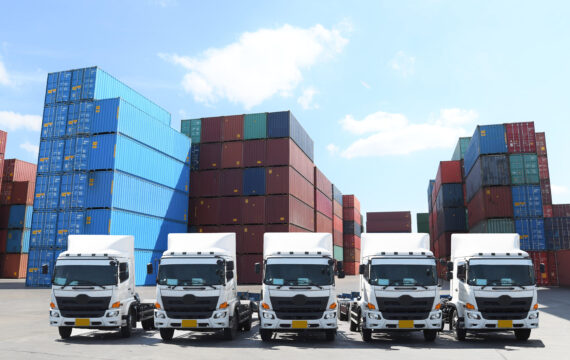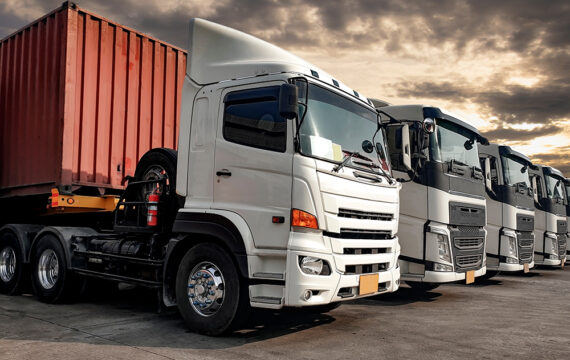Imagine you get a last-minute call right before going home. On the line is a happy farmer who has agreed with a partner to borrow a harvesting combine for the season. Now he needs coast-to-coast shipping across the entire US. The farmer tells you how this combine will solve all his troubles and skyrocket his agribusiness. You’re glad to help, and you ask what type of truck he’ll need to move it. All you hear is: “Oh, this one’s a big fella.” That’s where the trouble begins.
Keeping in mind all size restrictions, toll roads, permit costs, traffic information, rules for escort vehicles, and schedule factors for agriculture transportation of oversized equipment can lead to sleepless nights for fleet managers. Whether you’re an agricultural logistics company, an agricultural holding, or a private farmer arranging transportation of agriculture trucks, you should prepare your oversized transportation fleet for each curve in the road. Even a small mistake in cargo size or weight can violate road limitations, while inconsistencies in the planned route can cause a driver to take a wrong turn and stray from the schedule. Such mistakes can lead to cargo damage, fuel overruns, increased mileage, or even having to turn around halfway for non-compliance with road regulations.
So what would your answer to this farmer be? Of course you would help him. Sustainable agriculture transportation and Ag trucking are your bread and butter, after all. But before you start puzzling over how to transport this “big fella,” let’s find out the best practices in agriculture transportation and discover how to build a hassle-free route for oversized machinery that keeps your costs down and your customers satisfied. Hint: It’s all about route optimization software for transportation and logistics.
What to consider before starting transportation of agriculture trucks
By oversized equipment, we mean heavy agricultural machinery, airspace hauls, construction equipment, and other equipment that you can hardly imagine putting on a standard truck bed. Even as we see all kinds of new sustainable agriculture transportation technologies to help in different industries, we still run into old problems of how to transport equipment to make the most use of it.
Types of oversized agricultural machinery

Hauling heavy loads may entail a lot of indirect costs if done incorrectly. Logistics companies and their end customers ordering agriculture transportation of oversized machinery both need to consider the following factors to minimize losses, stick to the schedule, and avoid any problems with shipping:
- Road restrictions for cargo size and weight
- The necessity to add additional markings, signs, or flags to point out the non-standard cargo size
- Permissions to take heavy loads on particular roads (may differ between states and countries)
- Additional insurance for large and expensive cargoes
- Shipping laws in each state
- Fleet maintenance issues after carrying heavy loads
- Additional workload for drivers due to increased job difficulty
- Escort option for transporting oversized equipment
- Traffic density along the entire route
- Transportation mapping software with custom map layers for oversized machinery fleets
- Smart and automated routing considering different factors
- Ability to secure cargo against theft with real-time tracking
Among all these factors that influence the cost and safety of agriculture transportation and Ag trucking, the most important to recognize are those that customers may want to forego to cut expenses.
How does heavy equipment fleet management software solve problems of agriculture transportation?

The route is a critical part of the cost calculation for hauling heavy cargoes and transportation of agriculture trucks in particular. Sure, you’ll need to select an appropriate truck and trailer and pay attention to state permissions, but choosing the route is the starting point. The ability to calculate an optimal route in advance using location data and services gives agriculture transportation service providers as well as their customers multiple benefits.
- Preliminary cost estimate
With detailed route planning, logistics service providers can know exact costs before transporting cargo, including fuel consumption, additional equipment costs for carrying non-standard loads, tolls, permissions, and other charges.
- End-to-end dynamic routing
Drivers can get an optimal route from point A to point B with real-time rebuilding options depending on traffic density and other unpredictable circumstances along the way.
- Exact time of arrival
Weighing all parameters, customers may receive an exact ETA from the transportation company and be ready to use the equipment the same day they receive it.
- Secure transportation
Fleet managers may track both the truck and cargo in real time, avoiding geofenced areas with the possibility to add escort vehicles for outside video monitoring.
How does route calculation work for sustainable agriculture transportation?
Agriculture transportation service providers may use heavy equipment fleet management software to haul oversized machinery with ease. A typical Ag trucking route optimization algorithm runs as follows:
- Enter start and destination points (and intermediate points if needed)
- Choose a cargo type, with size and weight parameters
- Choose a vehicle type, including number of axles and mass per axle
- Set a time/date when the cargo has to arrive
- Select the type of routing: fastest, cheapest, shortest, balanced
Ag trucking route optimization solution showcase

The market is saturated with commercial equipment management software for transportation of agriculture trucks with oversized cargo. But often, logistics and transportation service providers consider developing custom solutions for optimizing routes for heavy machinery to grow their business offerings. Such development requires narrow expertise in location-based transportation technologies as well as access to map data to build an optimal route. Custom route optimization software helps companies plan heavy equipment transportation (considering all relevant restrictions and factors on the road), apply custom map layers, and securely track fleets for further analytics and business optimization.
Intellias has experience working with AgTech solution providers as well as expertise in fleet route optimization, having built a proof of concept for smart routing of heavy agricultural machinery. Check out how this proof of concept works by watching the video below.
What did we use to develop a proof of concept for software that plans routes for transporting oversized machinery?
- Geocoding API by PTV xServer
- OpenStreetMap
- Custom map layer for heavy cargo
- Route optimization engine
What do transportation and logistics service providers get with route optimization for agriculture transportation?
You may need to orchestrate a variety of factors to haul oversized agricultural machinery to a farmer. Apart from trucks and all the equipment to maintain a powerful fleet, routing solutions can make the difference, allowing you to win loyal customers and outperform competitors. By building smart routes in advance, you’ll get these benefits:
- Flexibility with route types
You can propose several route options for customers to choose from, allowing them to deliver equipment faster or save costs as much as possible.
- Predictive fuel consumption and maintenance
With smart routes, your fleet can move from point A to point B without unpredicted turns for the driver and with predefined mileage, saving money on fuel. You may even pre-schedule a visit to service engineers for when the truck returns, knowing how many miles it will have driven and what issues may arise.
- Increased customer satisfaction
Providing a precise ETA delights your customers, allowing them to make plans to use the equipment knowing it will be delivered on time.
- Technology innovations
You can integrate map routing software with GPS fleet tracking to minimize the potential of theft, connect video streaming from escort vehicles to collect additional real-time data, and use smart navigation system to rebuild the route in case of an emergency.
- Strong customer relations
Evaluating the road before jumping in the driver’s seat helps you build wise pricing models, maintain your fleet more easily, be prepared for the next job, and improve transparency in customer relations.
Final thoughts
You don’t need to map all the messy roads all by yourself. Instead, you can plan optimal routes in a minute. Route optimization of heavy loads and oversized equipment ensures timely services, secure delivery, and cost efficiency. By taking the optimal route, you can nail your ETA every time you commit to transporting agricultural machinery for a farmer or construction parts for a newly built facility. You can optimize your fleet capacity with minimal downtime and a predictive maintenance plan as well as cut down on transportation costs by saving time and fuel. As a result, you can lower stress for customers, transportation service providers, drivers, and fleet managers.
If you’re in search of technical expertise to develop routing maps or to optimize the transport of agricultural machinery or construction equipment using oversized fleets, contact our Intellias experts in location-based technologies for engineering assistance. Together, we’ll drive your business faster.




